Aerospace Engineer Resume Examples

Jul 18, 2024
|
12 min read
Launch your aerospace engineer career with an impressive resume that soars. This guide will help you craft a standout document that captures attention and demonstrates your expertise in the field of aerospace engineering.
Rated by 348 people
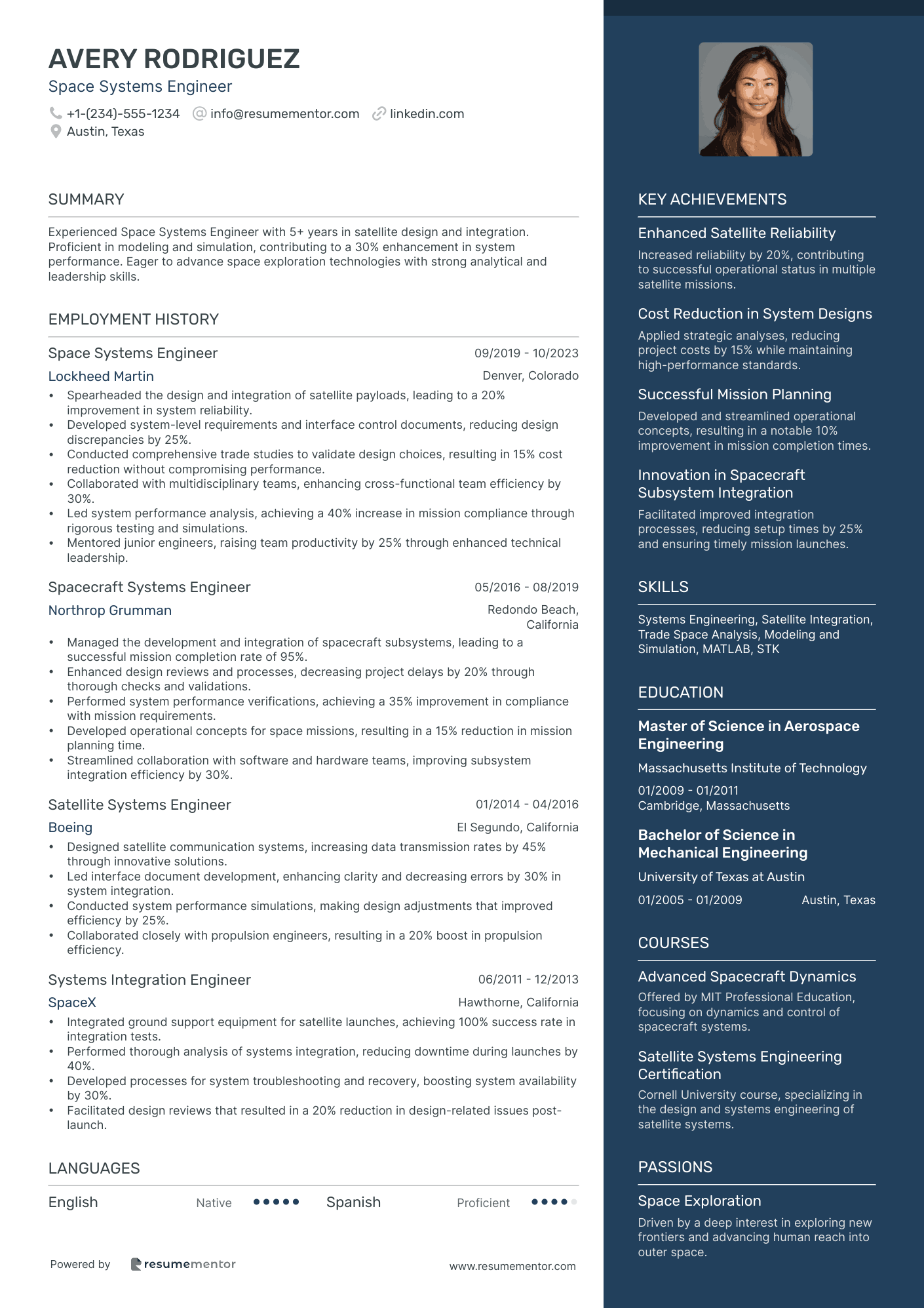
Space Systems Engineer
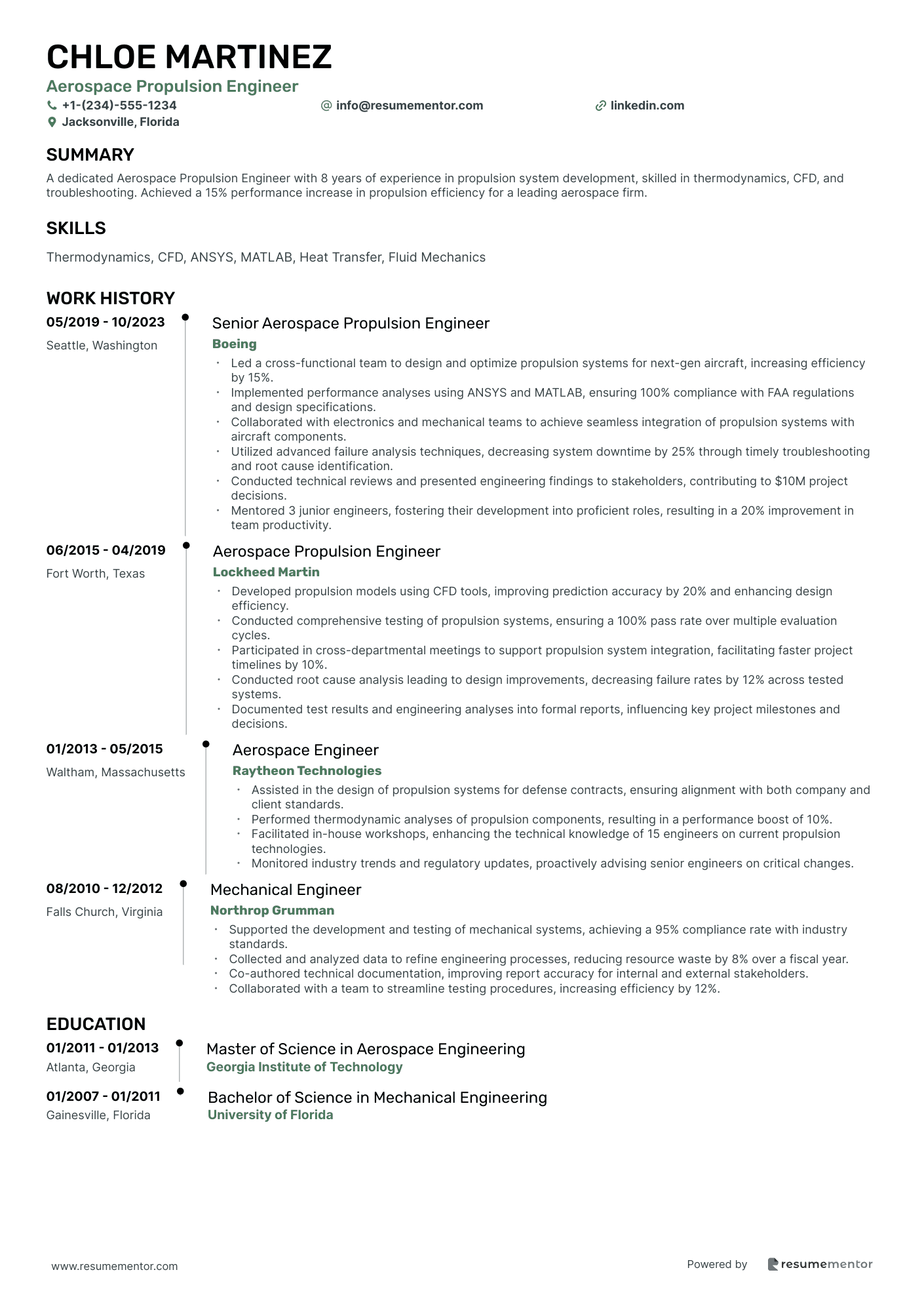
Aerospace Propulsion Engineer
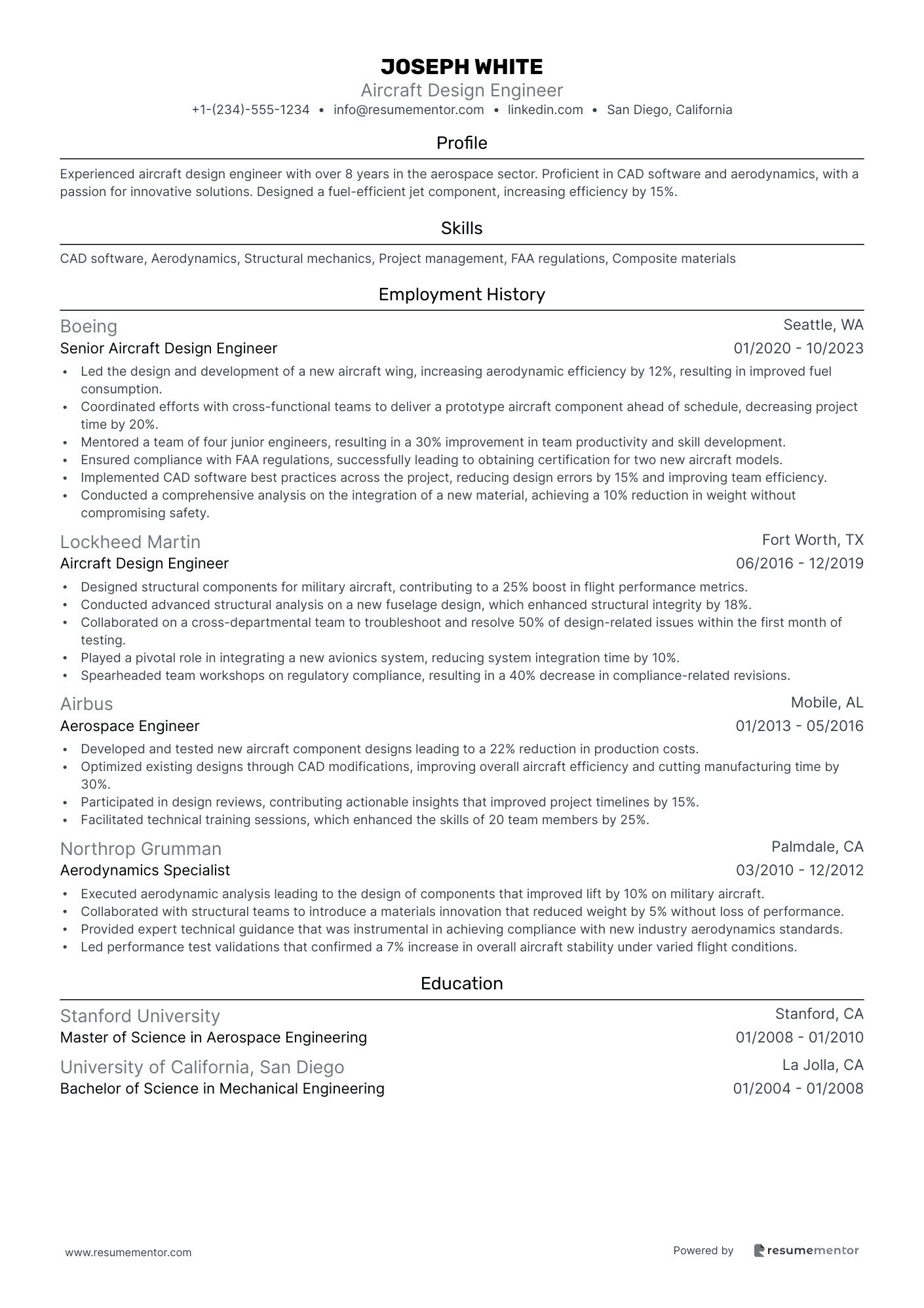
Aircraft Design Engineer
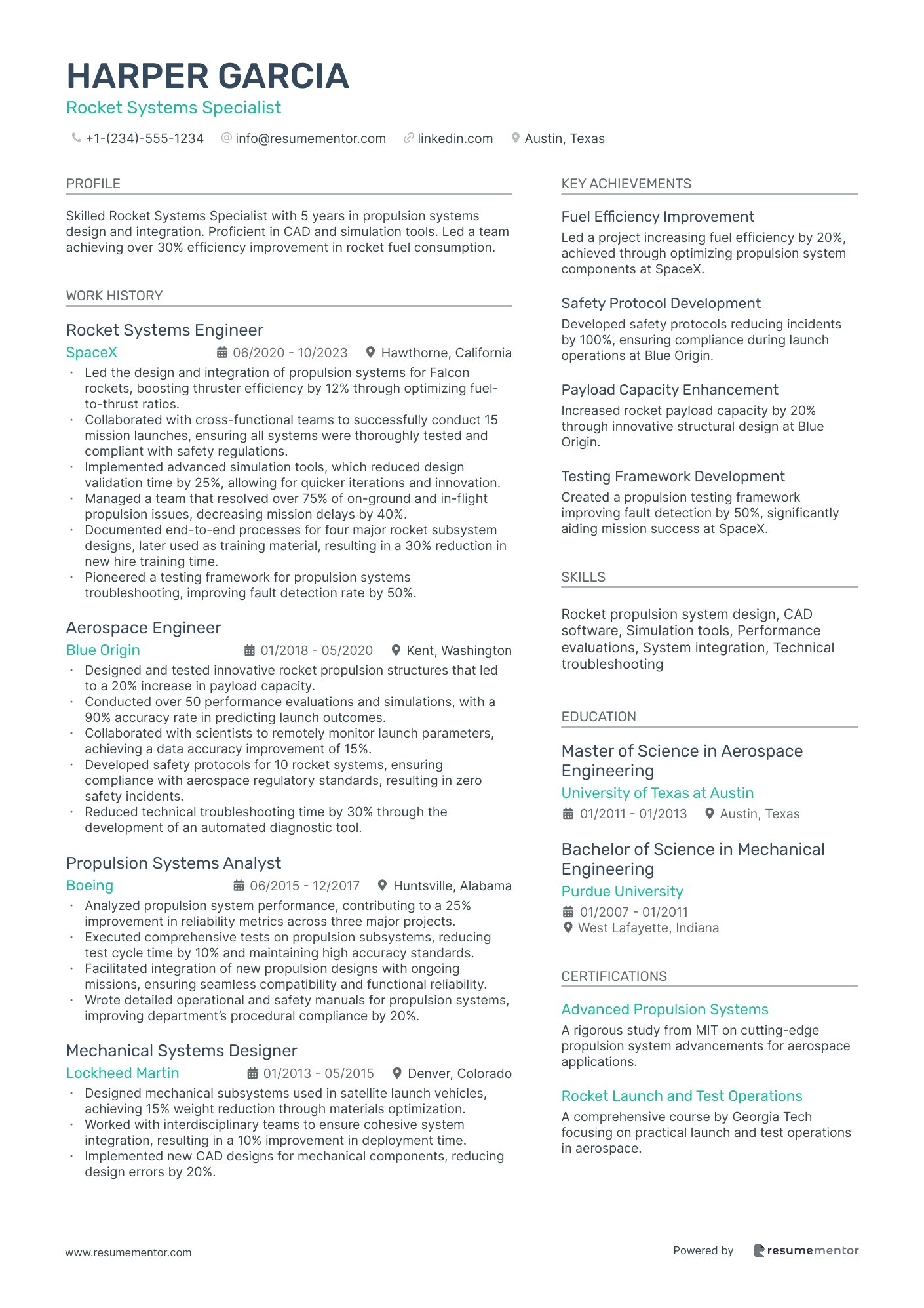
Rocket Systems Specialist
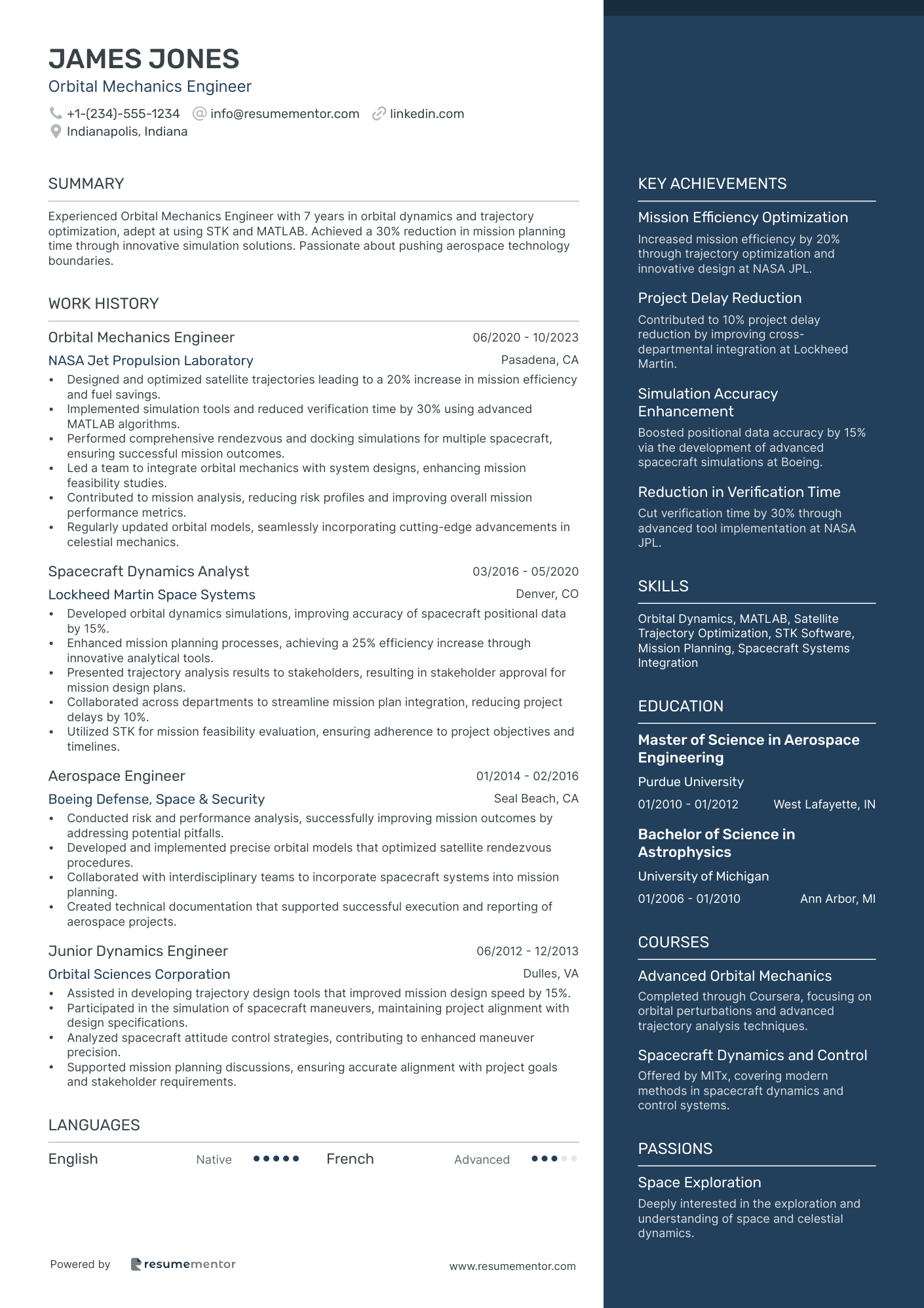
Orbital Mechanics Engineer
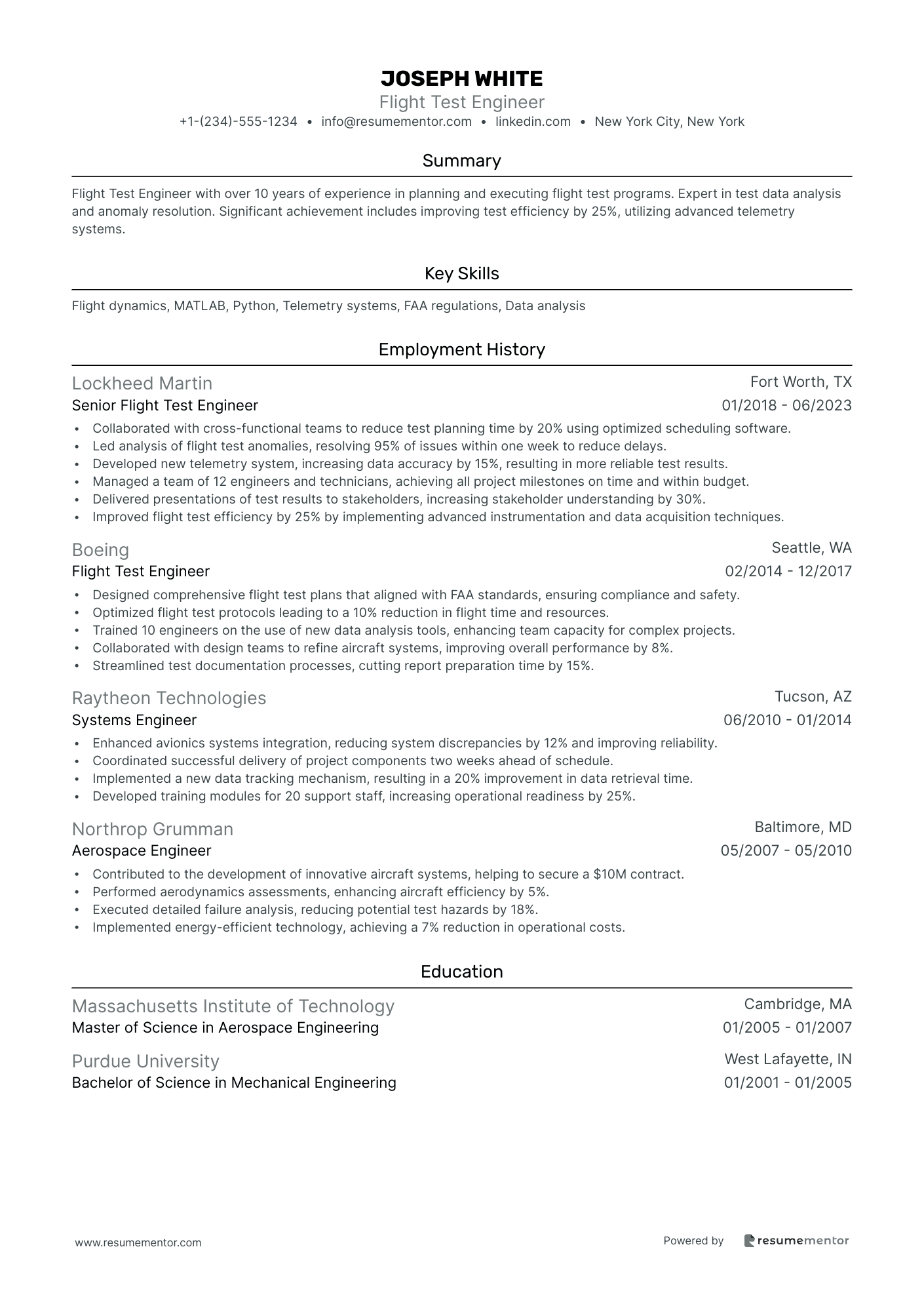
Flight Test Engineer
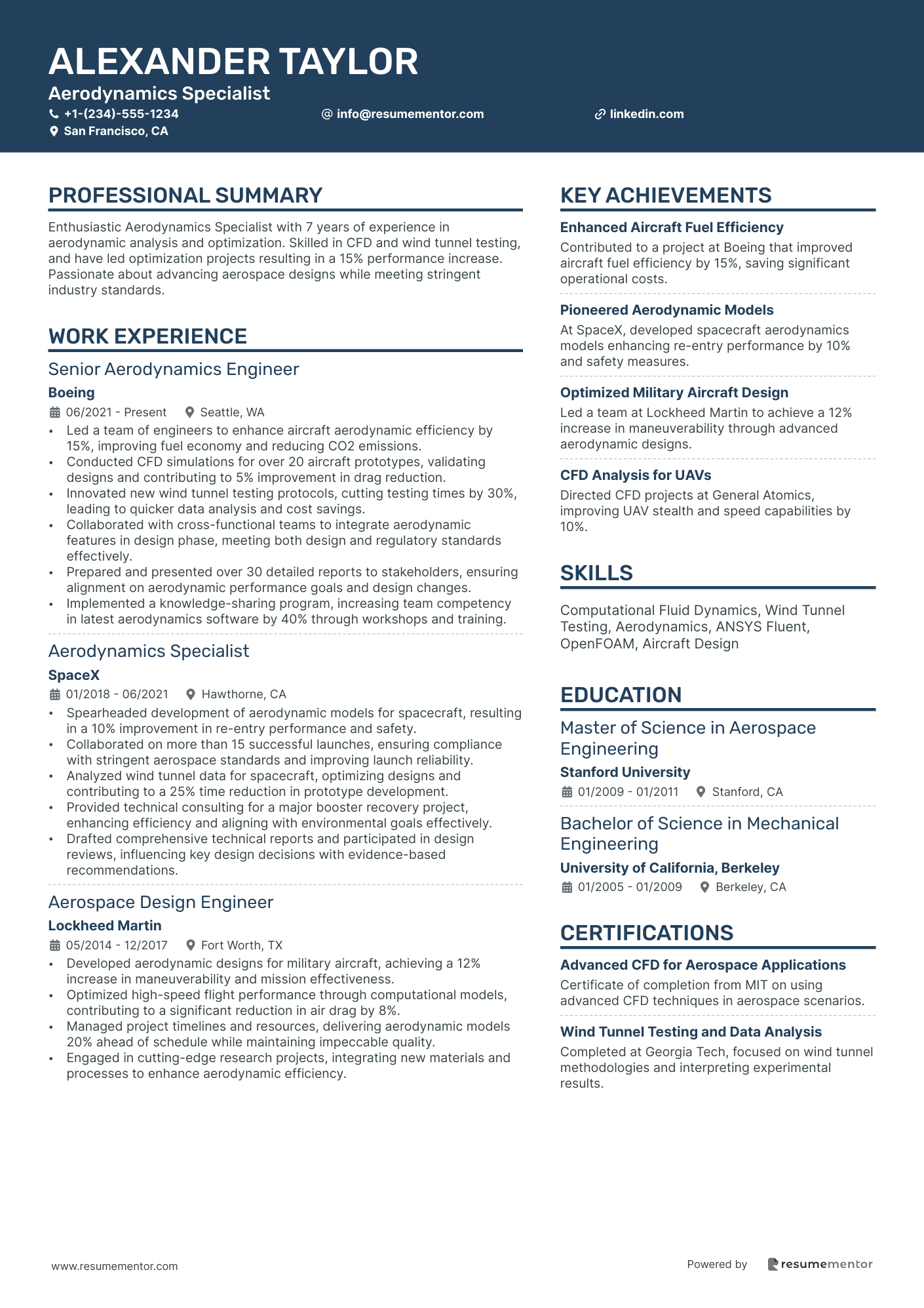
Aerodynamics Specialist
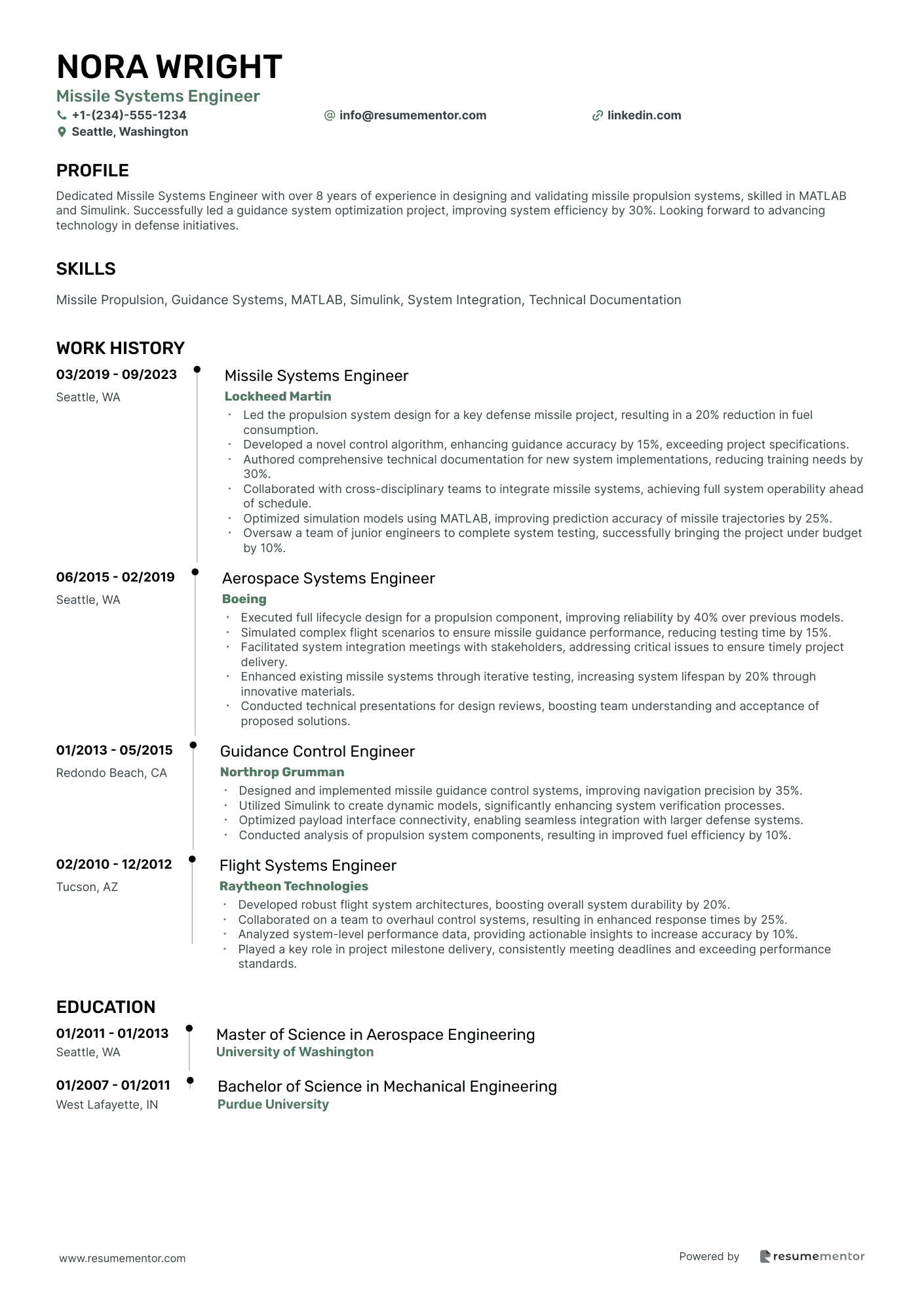
Missile Systems Engineer
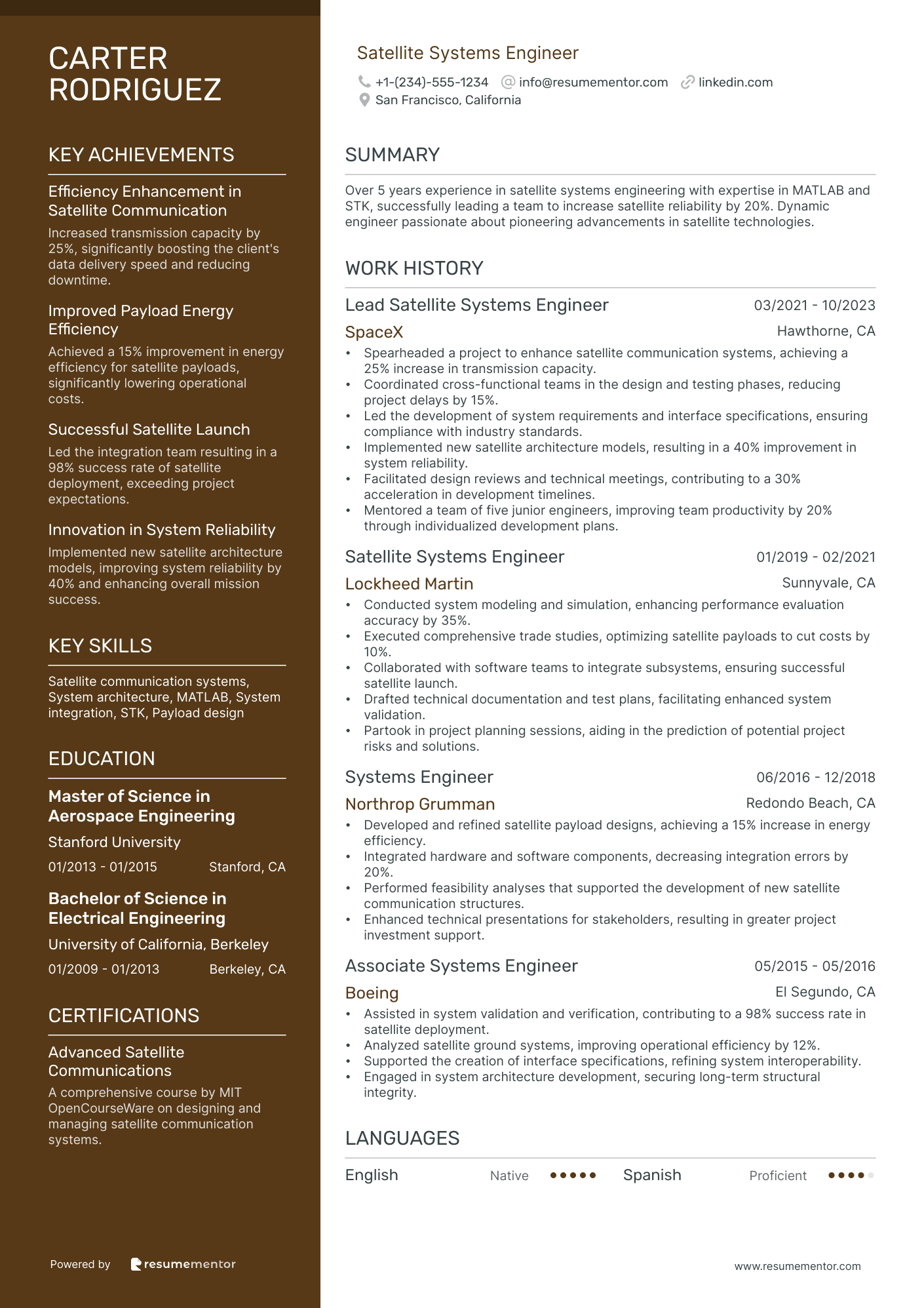
Satellite Systems Engineer
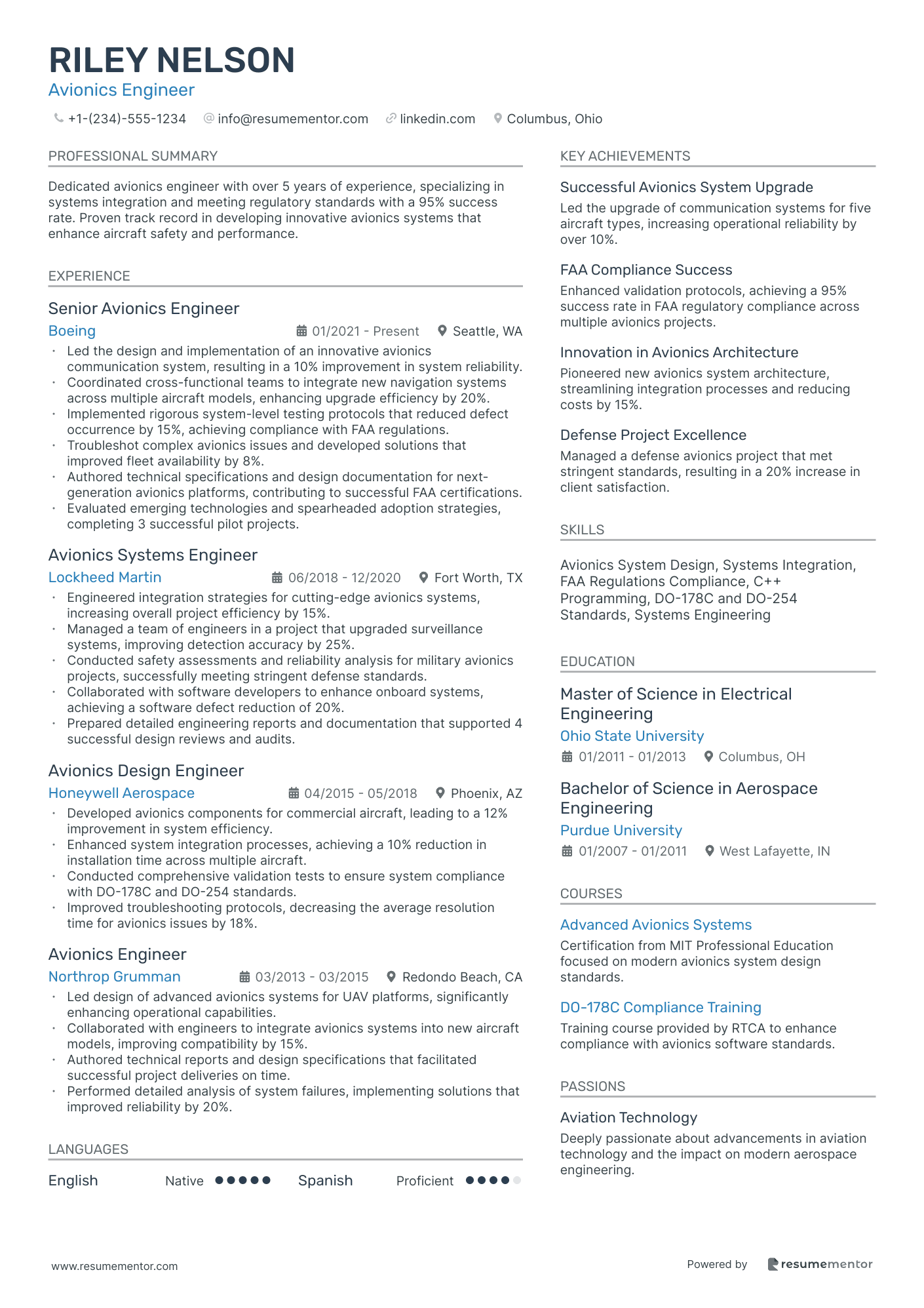
Avionics Engineer
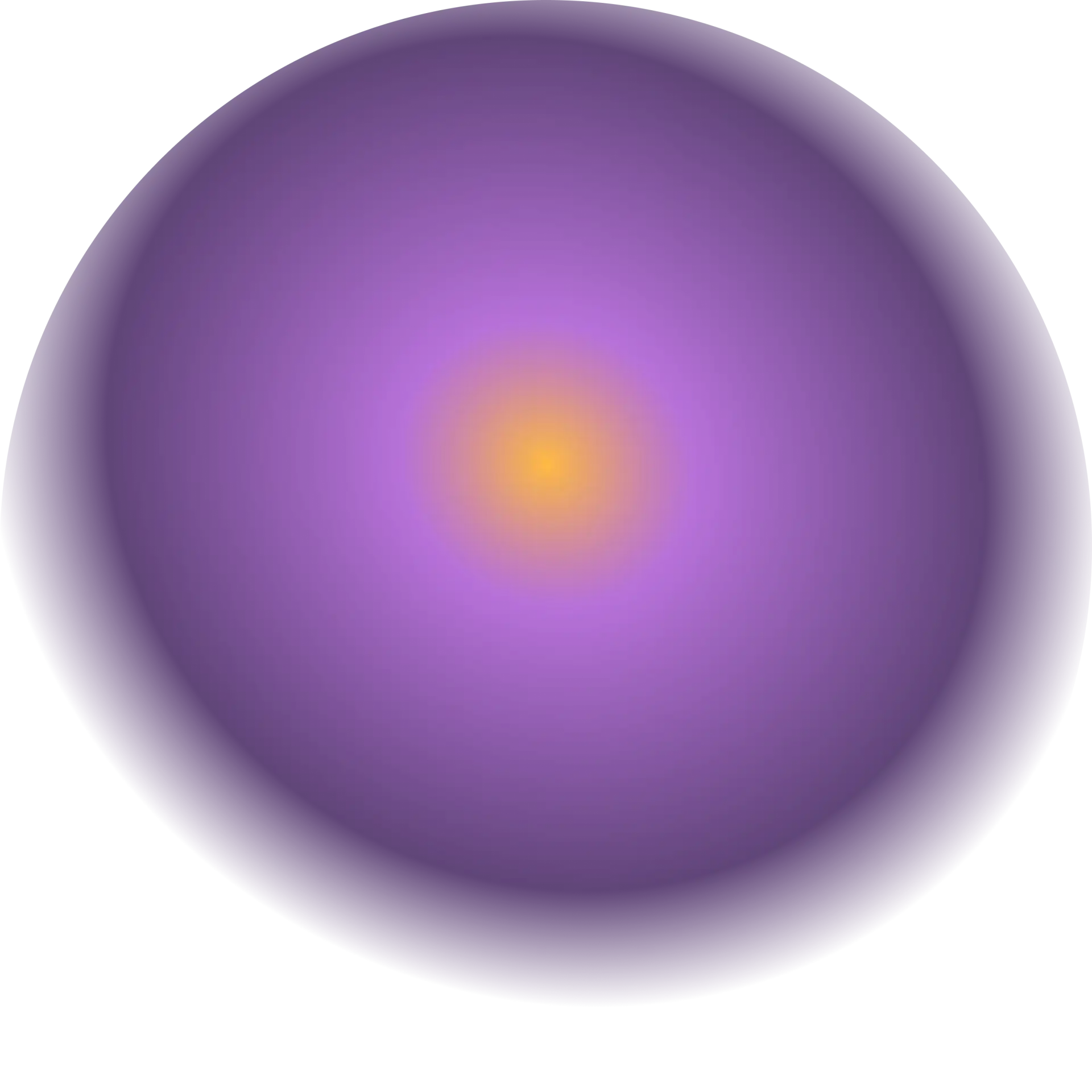
Space Systems Engineer resume sample
- •Spearheaded the design and integration of satellite payloads, leading to a 20% improvement in system reliability.
- •Developed system-level requirements and interface control documents, reducing design discrepancies by 25%.
- •Conducted comprehensive trade studies to validate design choices, resulting in 15% cost reduction without compromising performance.
- •Collaborated with multidisciplinary teams, enhancing cross-functional team efficiency by 30%.
- •Led system performance analysis, achieving a 40% increase in mission compliance through rigorous testing and simulations.
- •Mentored junior engineers, raising team productivity by 25% through enhanced technical leadership.
- •Managed the development and integration of spacecraft subsystems, leading to a successful mission completion rate of 95%.
- •Enhanced design reviews and processes, decreasing project delays by 20% through thorough checks and validations.
- •Performed system performance verifications, achieving a 35% improvement in compliance with mission requirements.
- •Developed operational concepts for space missions, resulting in a 15% reduction in mission planning time.
- •Streamlined collaboration with software and hardware teams, improving subsystem integration efficiency by 30%.
- •Designed satellite communication systems, increasing data transmission rates by 45% through innovative solutions.
- •Led interface document development, enhancing clarity and decreasing errors by 30% in system integration.
- •Conducted system performance simulations, making design adjustments that improved efficiency by 25%.
- •Collaborated closely with propulsion engineers, resulting in a 20% boost in propulsion efficiency.
- •Integrated ground support equipment for satellite launches, achieving 100% success rate in integration tests.
- •Performed thorough analysis of systems integration, reducing downtime during launches by 40%.
- •Developed processes for system troubleshooting and recovery, boosting system availability by 30%.
- •Facilitated design reviews that resulted in a 20% reduction in design-related issues post-launch.
Aerospace Propulsion Engineer resume sample
- •Led a cross-functional team to design and optimize propulsion systems for next-gen aircraft, increasing efficiency by 15%.
- •Implemented performance analyses using ANSYS and MATLAB, ensuring 100% compliance with FAA regulations and design specifications.
- •Collaborated with electronics and mechanical teams to achieve seamless integration of propulsion systems with aircraft components.
- •Utilized advanced failure analysis techniques, decreasing system downtime by 25% through timely troubleshooting and root cause identification.
- •Conducted technical reviews and presented engineering findings to stakeholders, contributing to $10M project decisions.
- •Mentored 3 junior engineers, fostering their development into proficient roles, resulting in a 20% improvement in team productivity.
- •Developed propulsion models using CFD tools, improving prediction accuracy by 20% and enhancing design efficiency.
- •Conducted comprehensive testing of propulsion systems, ensuring a 100% pass rate over multiple evaluation cycles.
- •Participated in cross-departmental meetings to support propulsion system integration, facilitating faster project timelines by 10%.
- •Conducted root cause analysis leading to design improvements, decreasing failure rates by 12% across tested systems.
- •Documented test results and engineering analyses into formal reports, influencing key project milestones and decisions.
- •Assisted in the design of propulsion systems for defense contracts, ensuring alignment with both company and client standards.
- •Performed thermodynamic analyses of propulsion components, resulting in a performance boost of 10%.
- •Facilitated in-house workshops, enhancing the technical knowledge of 15 engineers on current propulsion technologies.
- •Monitored industry trends and regulatory updates, proactively advising senior engineers on critical changes.
- •Supported the development and testing of mechanical systems, achieving a 95% compliance rate with industry standards.
- •Collected and analyzed data to refine engineering processes, reducing resource waste by 8% over a fiscal year.
- •Co-authored technical documentation, improving report accuracy for internal and external stakeholders.
- •Collaborated with a team to streamline testing procedures, increasing efficiency by 12%.
Aircraft Design Engineer resume sample
- •Led the design and development of a new aircraft wing, increasing aerodynamic efficiency by 12%, resulting in improved fuel consumption.
- •Coordinated efforts with cross-functional teams to deliver a prototype aircraft component ahead of schedule, decreasing project time by 20%.
- •Mentored a team of four junior engineers, resulting in a 30% improvement in team productivity and skill development.
- •Ensured compliance with FAA regulations, successfully leading to obtaining certification for two new aircraft models.
- •Implemented CAD software best practices across the project, reducing design errors by 15% and improving team efficiency.
- •Conducted a comprehensive analysis on the integration of a new material, achieving a 10% reduction in weight without compromising safety.
- •Designed structural components for military aircraft, contributing to a 25% boost in flight performance metrics.
- •Conducted advanced structural analysis on a new fuselage design, which enhanced structural integrity by 18%.
- •Collaborated on a cross-departmental team to troubleshoot and resolve 50% of design-related issues within the first month of testing.
- •Played a pivotal role in integrating a new avionics system, reducing system integration time by 10%.
- •Spearheaded team workshops on regulatory compliance, resulting in a 40% decrease in compliance-related revisions.
- •Developed and tested new aircraft component designs leading to a 22% reduction in production costs.
- •Optimized existing designs through CAD modifications, improving overall aircraft efficiency and cutting manufacturing time by 30%.
- •Participated in design reviews, contributing actionable insights that improved project timelines by 15%.
- •Facilitated technical training sessions, which enhanced the skills of 20 team members by 25%.
- •Executed aerodynamic analysis leading to the design of components that improved lift by 10% on military aircraft.
- •Collaborated with structural teams to introduce a materials innovation that reduced weight by 5% without loss of performance.
- •Provided expert technical guidance that was instrumental in achieving compliance with new industry aerodynamics standards.
- •Led performance test validations that confirmed a 7% increase in overall aircraft stability under varied flight conditions.
Rocket Systems Specialist resume sample
- •Led the design and integration of propulsion systems for Falcon rockets, boosting thruster efficiency by 12% through optimizing fuel-to-thrust ratios.
- •Collaborated with cross-functional teams to successfully conduct 15 mission launches, ensuring all systems were thoroughly tested and compliant with safety regulations.
- •Implemented advanced simulation tools, which reduced design validation time by 25%, allowing for quicker iterations and innovation.
- •Managed a team that resolved over 75% of on-ground and in-flight propulsion issues, decreasing mission delays by 40%.
- •Documented end-to-end processes for four major rocket subsystem designs, later used as training material, resulting in a 30% reduction in new hire training time.
- •Pioneered a testing framework for propulsion systems troubleshooting, improving fault detection rate by 50%.
- •Designed and tested innovative rocket propulsion structures that led to a 20% increase in payload capacity.
- •Conducted over 50 performance evaluations and simulations, with a 90% accuracy rate in predicting launch outcomes.
- •Collaborated with scientists to remotely monitor launch parameters, achieving a data accuracy improvement of 15%.
- •Developed safety protocols for 10 rocket systems, ensuring compliance with aerospace regulatory standards, resulting in zero safety incidents.
- •Reduced technical troubleshooting time by 30% through the development of an automated diagnostic tool.
- •Analyzed propulsion system performance, contributing to a 25% improvement in reliability metrics across three major projects.
- •Executed comprehensive tests on propulsion subsystems, reducing test cycle time by 10% and maintaining high accuracy standards.
- •Facilitated integration of new propulsion designs with ongoing missions, ensuring seamless compatibility and functional reliability.
- •Wrote detailed operational and safety manuals for propulsion systems, improving department’s procedural compliance by 20%.
- •Designed mechanical subsystems used in satellite launch vehicles, achieving 15% weight reduction through materials optimization.
- •Worked with interdisciplinary teams to ensure cohesive system integration, resulting in a 10% improvement in deployment time.
- •Implemented new CAD designs for mechanical components, reducing design errors by 20%.
Orbital Mechanics Engineer resume sample
- •Designed and optimized satellite trajectories leading to a 20% increase in mission efficiency and fuel savings.
- •Implemented simulation tools and reduced verification time by 30% using advanced MATLAB algorithms.
- •Performed comprehensive rendezvous and docking simulations for multiple spacecraft, ensuring successful mission outcomes.
- •Led a team to integrate orbital mechanics with system designs, enhancing mission feasibility studies.
- •Contributed to mission analysis, reducing risk profiles and improving overall mission performance metrics.
- •Regularly updated orbital models, seamlessly incorporating cutting-edge advancements in celestial mechanics.
- •Developed orbital dynamics simulations, improving accuracy of spacecraft positional data by 15%.
- •Enhanced mission planning processes, achieving a 25% efficiency increase through innovative analytical tools.
- •Presented trajectory analysis results to stakeholders, resulting in stakeholder approval for mission design plans.
- •Collaborated across departments to streamline mission plan integration, reducing project delays by 10%.
- •Utilized STK for mission feasibility evaluation, ensuring adherence to project objectives and timelines.
- •Conducted risk and performance analysis, successfully improving mission outcomes by addressing potential pitfalls.
- •Developed and implemented precise orbital models that optimized satellite rendezvous procedures.
- •Collaborated with interdisciplinary teams to incorporate spacecraft systems into mission planning.
- •Created technical documentation that supported successful execution and reporting of aerospace projects.
- •Assisted in developing trajectory design tools that improved mission design speed by 15%.
- •Participated in the simulation of spacecraft maneuvers, maintaining project alignment with design specifications.
- •Analyzed spacecraft attitude control strategies, contributing to enhanced maneuver precision.
- •Supported mission planning discussions, ensuring accurate alignment with project goals and stakeholder requirements.
Flight Test Engineer resume sample
- •Collaborated with cross-functional teams to reduce test planning time by 20% using optimized scheduling software.
- •Led analysis of flight test anomalies, resolving 95% of issues within one week to reduce delays.
- •Developed new telemetry system, increasing data accuracy by 15%, resulting in more reliable test results.
- •Managed a team of 12 engineers and technicians, achieving all project milestones on time and within budget.
- •Delivered presentations of test results to stakeholders, increasing stakeholder understanding by 30%.
- •Improved flight test efficiency by 25% by implementing advanced instrumentation and data acquisition techniques.
- •Designed comprehensive flight test plans that aligned with FAA standards, ensuring compliance and safety.
- •Optimized flight test protocols leading to a 10% reduction in flight time and resources.
- •Trained 10 engineers on the use of new data analysis tools, enhancing team capacity for complex projects.
- •Collaborated with design teams to refine aircraft systems, improving overall performance by 8%.
- •Streamlined test documentation processes, cutting report preparation time by 15%.
- •Enhanced avionics systems integration, reducing system discrepancies by 12% and improving reliability.
- •Coordinated successful delivery of project components two weeks ahead of schedule.
- •Implemented a new data tracking mechanism, resulting in a 20% improvement in data retrieval time.
- •Developed training modules for 20 support staff, increasing operational readiness by 25%.
- •Contributed to the development of innovative aircraft systems, helping to secure a $10M contract.
- •Performed aerodynamics assessments, enhancing aircraft efficiency by 5%.
- •Executed detailed failure analysis, reducing potential test hazards by 18%.
- •Implemented energy-efficient technology, achieving a 7% reduction in operational costs.
Aerodynamics Specialist resume sample
- •Led a team of engineers to enhance aircraft aerodynamic efficiency by 15%, improving fuel economy and reducing CO2 emissions.
- •Conducted CFD simulations for over 20 aircraft prototypes, validating designs and contributing to 5% improvement in drag reduction.
- •Innovated new wind tunnel testing protocols, cutting testing times by 30%, leading to quicker data analysis and cost savings.
- •Collaborated with cross-functional teams to integrate aerodynamic features in design phase, meeting both design and regulatory standards effectively.
- •Prepared and presented over 30 detailed reports to stakeholders, ensuring alignment on aerodynamic performance goals and design changes.
- •Implemented a knowledge-sharing program, increasing team competency in latest aerodynamics software by 40% through workshops and training.
- •Spearheaded development of aerodynamic models for spacecraft, resulting in a 10% improvement in re-entry performance and safety.
- •Collaborated on more than 15 successful launches, ensuring compliance with stringent aerospace standards and improving launch reliability.
- •Analyzed wind tunnel data for spacecraft, optimizing designs and contributing to a 25% time reduction in prototype development.
- •Provided technical consulting for a major booster recovery project, enhancing efficiency and aligning with environmental goals effectively.
- •Drafted comprehensive technical reports and participated in design reviews, influencing key design decisions with evidence-based recommendations.
- •Developed aerodynamic designs for military aircraft, achieving a 12% increase in maneuverability and mission effectiveness.
- •Optimized high-speed flight performance through computational models, contributing to a significant reduction in air drag by 8%.
- •Managed project timelines and resources, delivering aerodynamic models 20% ahead of schedule while maintaining impeccable quality.
- •Engaged in cutting-edge research projects, integrating new materials and processes to enhance aerodynamic efficiency.
- •Conducted CFD analysis for unmanned aerial vehicles, enhancing their stealth and speed capabilities by 10%.
- •Worked on aerodynamic surface designs that improved lift-to-drag ratios significantly, contributing to a 5% range increase.
- •Collaborated with a multidisciplinary team for prototyping, reducing the trial-and-error phase and increasing innovation speed.
- •Developed standard operating procedures for aerodynamic testing, improving test consistency and data reliability.
Missile Systems Engineer resume sample
- •Led the propulsion system design for a key defense missile project, resulting in a 20% reduction in fuel consumption.
- •Developed a novel control algorithm, enhancing guidance accuracy by 15%, exceeding project specifications.
- •Authored comprehensive technical documentation for new system implementations, reducing training needs by 30%.
- •Collaborated with cross-disciplinary teams to integrate missile systems, achieving full system operability ahead of schedule.
- •Optimized simulation models using MATLAB, improving prediction accuracy of missile trajectories by 25%.
- •Oversaw a team of junior engineers to complete system testing, successfully bringing the project under budget by 10%.
- •Executed full lifecycle design for a propulsion component, improving reliability by 40% over previous models.
- •Simulated complex flight scenarios to ensure missile guidance performance, reducing testing time by 15%.
- •Facilitated system integration meetings with stakeholders, addressing critical issues to ensure timely project delivery.
- •Enhanced existing missile systems through iterative testing, increasing system lifespan by 20% through innovative materials.
- •Conducted technical presentations for design reviews, boosting team understanding and acceptance of proposed solutions.
- •Designed and implemented missile guidance control systems, improving navigation precision by 35%.
- •Utilized Simulink to create dynamic models, significantly enhancing system verification processes.
- •Optimized payload interface connectivity, enabling seamless integration with larger defense systems.
- •Conducted analysis of propulsion system components, resulting in improved fuel efficiency by 10%.
- •Developed robust flight system architectures, boosting overall system durability by 20%.
- •Collaborated on a team to overhaul control systems, resulting in enhanced response times by 25%.
- •Analyzed system-level performance data, providing actionable insights to increase accuracy by 10%.
- •Played a key role in project milestone delivery, consistently meeting deadlines and exceeding performance standards.
Satellite Systems Engineer resume sample
- •Spearheaded a project to enhance satellite communication systems, achieving a 25% increase in transmission capacity.
- •Coordinated cross-functional teams in the design and testing phases, reducing project delays by 15%.
- •Led the development of system requirements and interface specifications, ensuring compliance with industry standards.
- •Implemented new satellite architecture models, resulting in a 40% improvement in system reliability.
- •Facilitated design reviews and technical meetings, contributing to a 30% acceleration in development timelines.
- •Mentored a team of five junior engineers, improving team productivity by 20% through individualized development plans.
- •Conducted system modeling and simulation, enhancing performance evaluation accuracy by 35%.
- •Executed comprehensive trade studies, optimizing satellite payloads to cut costs by 10%.
- •Collaborated with software teams to integrate subsystems, ensuring successful satellite launch.
- •Drafted technical documentation and test plans, facilitating enhanced system validation.
- •Partook in project planning sessions, aiding in the prediction of potential project risks and solutions.
- •Developed and refined satellite payload designs, achieving a 15% increase in energy efficiency.
- •Integrated hardware and software components, decreasing integration errors by 20%.
- •Performed feasibility analyses that supported the development of new satellite communication structures.
- •Enhanced technical presentations for stakeholders, resulting in greater project investment support.
- •Assisted in system validation and verification, contributing to a 98% success rate in satellite deployment.
- •Analyzed satellite ground systems, improving operational efficiency by 12%.
- •Supported the creation of interface specifications, refining system interoperability.
- •Engaged in system architecture development, securing long-term structural integrity.
Avionics Engineer resume sample
- •Led the design and implementation of an innovative avionics communication system, resulting in a 10% improvement in system reliability.
- •Coordinated cross-functional teams to integrate new navigation systems across multiple aircraft models, enhancing upgrade efficiency by 20%.
- •Implemented rigorous system-level testing protocols that reduced defect occurrence by 15%, achieving compliance with FAA regulations.
- •Troubleshot complex avionics issues and developed solutions that improved fleet availability by 8%.
- •Authored technical specifications and design documentation for next-generation avionics platforms, contributing to successful FAA certifications.
- •Evaluated emerging technologies and spearheaded adoption strategies, completing 3 successful pilot projects.
- •Engineered integration strategies for cutting-edge avionics systems, increasing overall project efficiency by 15%.
- •Managed a team of engineers in a project that upgraded surveillance systems, improving detection accuracy by 25%.
- •Conducted safety assessments and reliability analysis for military avionics projects, successfully meeting stringent defense standards.
- •Collaborated with software developers to enhance onboard systems, achieving a software defect reduction of 20%.
- •Prepared detailed engineering reports and documentation that supported 4 successful design reviews and audits.
- •Developed avionics components for commercial aircraft, leading to a 12% improvement in system efficiency.
- •Enhanced system integration processes, achieving a 10% reduction in installation time across multiple aircraft.
- •Conducted comprehensive validation tests to ensure system compliance with DO-178C and DO-254 standards.
- •Improved troubleshooting protocols, decreasing the average resolution time for avionics issues by 18%.
- •Led design of advanced avionics systems for UAV platforms, significantly enhancing operational capabilities.
- •Collaborated with engineers to integrate avionics systems into new aircraft models, improving compatibility by 15%.
- •Authored technical reports and design specifications that facilitated successful project deliveries on time.
- •Performed detailed analysis of system failures, implementing solutions that improved reliability by 20%.
As an aerospace engineer, your resume serves as the flight plan that guides potential employers through your career journey. While you excel at navigating complex projects and overcoming technical challenges in the field, transforming those diverse skills into a concise resume can be overwhelming. This guide will help you channel your engineering prowess into a compelling document that captures attention.
Your expertise in aerodynamics and propulsion systems is impressive, yet translating that into a resume isn’t always straightforward. It’s essential to communicate your proficiency with design software and highlight your successful projects effectively. Since employers are eager to grasp your achievements quickly, finding the right balance between technical detail and clarity becomes crucial.
To ease this process, using a resume template can provide a structured framework for organizing your skills, experience, and accomplishments. This ensures that your resume reflects the precision and innovation intrinsic to your work in aerospace engineering.
A well-structured template allows you to customize your resume, emphasizing your particular contributions to areas like aerodynamics, systems integration, or space exploration. In a competitive field, your goal is to make your resume stand out. By aligning your achievements with the role you’re aiming for, you create a document that not only catches attention but also truly soars.
Key Takeaways
- An aerospace engineer resume should clearly articulate technical skills, problem-solving abilities, and teamwork experience, focusing on contributions like improving aircraft and spacecraft systems.
- Utilizing a structured resume template can help organize skills, experiences, and accomplishments to reflect an engineer’s precision and innovation while distinguishing oneself in the competitive field.
- Reverse-chronological resume formatting is effective to showcase the most recent roles and achievements clearly, while careful font and layout choices enhance professionalism.
- Experience sections should focus on quantified achievements and the positive impact made in prior roles, using strong action words and industry-specific keywords.
- Including relevant certifications, skills, and additional sections such as language proficiency, hobbies, and volunteer work can enrich the resume, providing a comprehensive view of professional and personal attributes.
What to focus on when writing your aerospace engineer resume
An aerospace engineer resume should clearly convey your technical skills, problem-solving abilities, and teamwork experience. It's important for recruiters to see your contributions in designing, testing, and enhancing aircraft and spacecraft systems.
How to structure your aerospace engineer resume
- Contact Information — Start with your full name, phone number, email address, and LinkedIn profile to ensure recruiters can easily reach you. It's essential that contact details are updated regularly, so hiring managers encounter no issues in reaching out for further discussions. Ensure your email address is professional and includes your name to maintain a formal tone.
- Professional Summary — Follow with a brief, engaging paragraph that outlines your aerospace engineering experience and career goals. Use active language to emphasize your core competencies, like "aerodynamics," "aircraft systems," and "project management." Tailor this section to the specific position, mentioning your passion for innovations and continuous improvement, which are crucial in the aerospace industry.
- Experience — In this section, detail your work history with job titles, employers, and dates. Emphasize your roles in areas such as improving propulsion systems, leading safety projects, or collaborating on technology innovations, showing a clear career trajectory. Use quantifiable achievements to highlight the impact you've made, such as cost savings or efficiency improvements, making your contributions more tangible.
- Education — Your academic background is next, listing your degrees in aerospace engineering or related fields. Highlight coursework like fluid dynamics or spacecraft design that supports your practical experience. If you underwent any specialized training or attended relevant seminars, mention these to demonstrate a commitment to ongoing education and staying updated with industry advancements.
- Skills — Here, outline critical technical skills such as proficiency in CAD software, structural analysis, and understanding of FAA regulations. Presenting a balanced mix of technical and soft skills like teamwork and communication reinforces your ability to contribute effectively to multidisciplinary projects.
- Projects — Showcase key projects with summaries that note outcomes or innovations, mentioning any patents or notable contributions you've made to aerospace technology. Describing your approach to challenges and how you achieved goals demonstrates your problem-solving capacity.
This comprehensive layout prepares you to further explore each section in-depth, focusing on how to format your resume effectively. Below, we'll dive into more details on crafting an impressive aerospace engineer resume format.
Which resume format to choose
When crafting your aerospace engineer resume, the reverse-chronological format is a strategic choice. This method highlights your most recent roles and achievements, making it easy for potential employers to see your progression and current expertise right away. The roles you’ve undertaken and the skills you have honed over time are best showcased in this format, as it lays out your career path clearly and logically.
In terms of appearance, opting for modern fonts like Raleway, Montserrat, or Lato can make a significant impact. These fonts lend a sleek and contemporary feel to your resume, reflecting a forward-thinking mindset that aligns well with the high-tech nature of aerospace engineering. While font choice might seem minor, it sets the visual tone of your document and contributes to a professional impression.
Ensuring your resume is consistently displayed, regardless of the device it's viewed on, is crucial. That's why saving your document as a PDF is highly recommended. This guarantees that your carefully structured layout and design choices remain intact, preserving your professional image.
Finally, keeping your margins at about one inch all around creates a balanced look. This spacing not only makes your resume easier to read but also ensures that it appears clean and organized. This attention to detail reflects your precision and care, qualities essential to a successful career in aerospace engineering. By focusing on these elements, your resume will effectively communicate your qualifications and readiness for the role.
How to write a quantifiable resume experience section
Aerospace engineering resumes are most effective when the experience section highlights your achievements and the impact you’ve made in previous roles. This section is crucial because it communicates how your past work can benefit potential employers. Start with your most recent experience and organize it in reverse chronological order. Aim to cover around 10-15 years, ensuring relevance to the position you want. Use clear job titles like "Aerospace Engineer" or "Flight Systems Analyst" that resonate within the industry. Tailor each entry by integrating keywords from the job ad, and enhance the narrative with action words like "developed" and "led" to convey initiative and success.
Structuring your experience effectively involves providing concrete examples:
- •Engineered a UAV design that boosted flight efficiency by 25%, saving $2M in costs.
- •Developed an aerodynamic analysis tool that cut design time by 15%, increasing project throughput.
- •Led a team of 5 engineers through a multi-phase project, delivering each phase on time and under budget.
- •Implemented a testing protocol that improved system reliability by 30%, enhancing customer satisfaction.
This experience section effectively ties together your role and impact by offering measurable achievements. Each bullet point not only outlines what you accomplished but also specifies how the company benefited, which is vital for employers. By keeping the structure clear, hiring managers can easily understand your contributions. This cohesive strategy aligns your accomplishments with the aerospace industry’s goals, ensuring your resume resonates well through the use of specific keywords from job ads, making you stand out in a competitive field.
Technology-Focused resume experience section
A technology-focused aerospace engineer resume experience section should clearly showcase your expertise and achievements. Begin by highlighting projects or roles that underline your technological prowess. Describe the systems, tools, or processes you worked with, and emphasize your accomplishments rather than simply listing duties. Use strong action verbs to lead your descriptions, making it easy for anyone to quickly grasp your qualifications.
Focus on the specific contributions you've made, particularly those reflecting technical excellence and innovation. Whenever possible, quantify your accomplishments to demonstrate the real impact of your work, like enhancing efficiency or successfully completing key projects. Each entry should highlight a responsibility or success that underscores your aerospace technology expertise. Tailor this section to fit the job you're applying for by focusing on skills and achievements that align with the role.
Senior Aerospace Engineer
AeroDynamics Inc.
June 2018 - Present
- Led a team to design and implement a new flight control system, enhancing aircraft stability by 25%
- Collaborated with cross-functional teams to integrate advanced navigation technologies
- Devised testing protocols that reduced validation time by 30%, accelerating project timelines
- Implemented cost-effective solutions, saving the company $500,000 annually
Skills-Focused resume experience section
A skills-focused aerospace engineer resume experience section should clearly highlight the abilities that define your professional impact. Emphasize the essential skills like problem-solving, design, analysis, and teamwork, and illustrate how you've applied them in your past roles. Use straightforward language to detail how these skills have led to significant results, noting any measurable outcomes. Demonstrating your value to potential employers by sharing specific examples of your work will make your resume stand out.
Senior Aerospace Engineer
AeroTech Innovations
June 2020 - Present
- Led a team of engineers to redesign the wing structure, boosting fuel efficiency by 15%
- Used CAD software to model stress distribution, enhancing component durability
- Worked closely with cross-functional teams to integrate new materials, cutting overall weight by 10%
- Conducted wind tunnel tests to validate aerodynamic improvements, ensuring compliance with industry standards
Achievement-Focused resume experience section
A well-crafted achievement-focused aerospace engineer resume experience section should clearly highlight your key contributions and impact. Begin by selecting the achievements and projects that best showcase your skills, ensuring they align with the job you're targeting. As you craft each bullet point, aim to convey how your work made a difference, using numbers to quantify your contributions where appropriate. Employ action verbs and concise language to focus on the results of your efforts, demonstrating your ability to help your team or company achieve its goals.
Your bullet points should weave a narrative of success, detailing the innovations you introduced, methods you improved, and the successful outcomes of your projects. Be specific about the efficiencies you increased, costs you reduced, or the design and functionality improvements you implemented. Adding tangible data, such as percentages or awards, deepens the impact of your claims. By using result-oriented language, you connect your skills to potential contributions, giving employers a comprehensive view of what you bring to the table.
Senior Aerospace Engineer
SkyTech Innovations
2018 - 2022
- Led a team to design and test a new propulsion system, boosting efficiency by 20%.
- Developed models that enhanced structural integrity by 15%.
- Managed cross-functional teams, cutting prototype development time by 30%.
- Secured a patent for an aerodynamics feature that reduced fuel consumption.
Innovation-Focused resume experience section
An innovation-focused aerospace engineer resume experience section should highlight your knack for developing new solutions and refining existing systems. Start by showcasing projects where you took a leading role in deploying new technologies or methods, clearly outlining your specific contributions and the measurable improvements achieved. This approach helps demonstrate the positive impact of your innovative thinking on both projects and teams, illustrating how your unique contributions have driven success.
Organize your achievements with bullet points, focusing on the tangible effects of your innovations. For instance, mention designing a new component or system that met industry standards while also reducing costs. Highlight instances where you worked closely with diverse teams, successfully combining different areas of expertise to deliver groundbreaking results. This keeps the narrative assertive and focused, portraying your creativity and technical skills effectively through your career milestones.
Lead Aerospace Engineer
AeroTech Innovations
June 2020 - Present
- Developed a cutting-edge propulsion system that improved fuel efficiency by 15%, leading to major cost savings.
- Led a team to create a lightweight composite material, reducing aircraft weight by 10% and increasing performance.
- Collaborated with electronics engineers to enhance avionics systems, elevating aircraft safety and reliability.
- Spearheaded a project to integrate AI-powered diagnostics, decreasing maintenance downtime by 30%.
Write your aerospace engineer resume summary section
A skill-focused aerospace engineer resume summary should create a lasting impression by highlighting your most significant achievements and skills. This crucial section should concisely illustrate your professional journey and what you offer to prospective employers. It's your chance to communicate your strengths while tailoring your message to the job you're eyeing. Consider how an effective summary can be crafted:
This summary seamlessly integrates your quantified achievements, specified skills, and leadership capabilities. The goal is to reflect the precision and excellence demanded of an aerospace engineer. However, if you're early in your career, a resume objective might be more fitting. It shifts focus to future aspirations and goals, expressing your intentions in joining the company:
[here was the JSON object 2]
While objectives spotlight ambitions for beginners, a resume profile offers a broader perspective, combining professional and personal attributes. In contrast, a summary of qualifications focuses on listing key skills and competencies. Choosing the right format—whether it's a summary, objective, profile, or qualifications list—depends on your career stage and what aligns best with your story. A well-crafted introduction sets a compelling tone for the rest of your resume, emphasizing how you're the right fit for the job.
Listing your aerospace engineer skills on your resume
Writing the Skills Section for an Aerospace Engineer Resume
A skills-focused aerospace engineer resume should clearly present your technical abilities alongside your personal strengths. Whether your skills section stands alone or is integrated into other parts of your resume, such as the experience or summary sections, it's important to include both strengths and soft skills along with your hard skills. Strengths are the natural talents that you bring to the table, while soft skills reflect personal attributes that enhance your ability to work well with others. Hard skills, however, are the technical know-how you’ve gained through education or hands-on experience.
By using relevant skills and strengths as keywords throughout your resume, you make it easier for employers to quickly understand your qualifications. This approach ensures that hiring managers can easily spot how well you match the job description.
Here’s an example of how you might present a standalone skills section:
This section effectively focuses on skills directly related to aerospace engineering, offering potential employers a clear, organized view of your capabilities.
Best Hard Skills to Feature on Your Aerospace Engineer Resume
Hard skills are crucial in the field of aerospace engineering, as they demonstrate your technical expertise and ability to manage complex projects and systems. Highlighting these skills shows potential employers that you have the competence needed to excel in the role.
Hard Skills
- Aerodynamics Analysis
- Computational Fluid Dynamics (CFD)
- CAD Software Proficiency
- Structural Analysis
- Material Science
- Systems Engineering
- Propulsion Systems
- Project Management
- Thermal Analysis
- Avionics Systems
- Navigation Systems
- Aeronautical Testing
- Robotics and Automation
- Finite Element Analysis (FEA)
- Data Analysis
Best Soft Skills to Feature on Your Aerospace Engineer Resume
Equally important are soft skills, which reveal how you interact with others and handle workplace challenges. These skills are essential for effective teamwork, problem-solving, and communication in aerospace engineering settings.
Soft Skills
- Problem-Solving
- Critical Thinking
- Team Collaboration
- Effective Communication
- Adaptability
- Attention to Detail
- Leadership
- Creativity
- Initiative
- Decision-Making
- Time Management
- Analytical Skills
- Active Listening
- Conflict Resolution
- Empathy
How to include your education on your resume
The education section of your aerospace engineer resume is crucial as it highlights your academic background and qualifications to employers. This section should be tailored to the job you're applying for, meaning any education unrelated to aerospace engineering should be omitted. If your degree is relevant, make it stand out clearly. Include your GPA if it is impressive, typically 3.5 or higher, such as "GPA: 3.8/4.0". When listing honors like cum laude, include it alongside your degree title, "Bachelor of Science in Aerospace Engineering, cum laude". Always list your degree first, followed by the institution's name, location, and the completion date. Below is an example of a poor and an excellent education section to help you format yours correctly.
Here is an example of a poor education section:
In contrast, here is an outstanding example:
The second example is effective because it directly relates to aerospace engineering, increasing its relevance to potential employers. The use of "cum laude" highlights academic achievement, and the GPA is prominently displayed, showcasing excellence. The absence of unnecessary details keeps it concise and focused, ensuring the recruiter can quickly assess your qualifications.
How to include aerospace engineer certificates on your resume
A certificates section is crucial for any aerospace engineer's resume, as it highlights qualifications and specialized skills. List the name of each certificate clearly. Include the date when the certificate was earned. Add the issuing organization to provide credibility. Certificates can also be mentioned in the header to grab attention quickly. Here’s how you could put it together:
This example is effective because it provides relevant certificates that demonstrate expertise in aerospace technology and CAD skills. The titles are specific and credible, and the inclusion of issuing organizations further strengthens your qualifications.
Extra sections to include in your aerospace engineer resume
Crafting a compelling resume is crucial for landing a job in the highly competitive field of aerospace engineering. In addition to showcasing your technical skills and experience, including other relevant sections can make your resume stand out. These sections provide a more rounded picture of who you are and what you bring to the table.
Language section — Highlight proficiency in relevant languages. Enhance your global communication skills and make you more versatile.
Hobbies and interests section — Demonstrate a well-rounded personality through unique hobbies or interests. Show your potential for teamwork and creativity.
Volunteer work section — Showcase your commitment to the community and leadership qualities. Add depth to your character and illustrate your soft skills.
Books section — List influential books related to your field. Indicate a continuous desire to learn and stay updated on industry trends.
By integrating these sections, you not only underline your technical prowess but also build a richer, more engaging profile. This approach increases the likelihood of connecting with hiring managers on various levels.
In Conclusion
In conclusion, as an aerospace engineer, your resume is not just a document but a strategic tool that can propel you into your desired career trajectory. Crafting a resume that accurately reflects your skills, experience, and achievements requires attention to detail and careful consideration of format and content. By employing a structured approach and utilizing a well-organized template, you elevate your ability to present your qualifications effectively. A reverse-chronological format, along with modern font choices and concise summaries, ensures your resume remains clear and professional. Emphasizing quantifiable achievements in various sections helps potential employers grasp the impact of your contributions swiftly. Highlighting technical and soft skills tailored to the aerospace industry further differentiates you in a competitive job market. By detailing educational accomplishments and certifications, you reinforce your credibility and commitment to professional growth. Additionally, including extra sections like language proficiency or volunteer work can offer a holistic view of your capabilities and values. Each component of your resume should be crafted with an eye toward connecting your past experiences with future potential, ensuring you stand out as a top candidate ready to tackle new challenges in aerospace engineering.
Related Articles

Continue Reading
Check more recommended readings to get the job of your dreams.
Resume
Resources
Tools
© 2025. All rights reserved.
Made with love by people who care.

